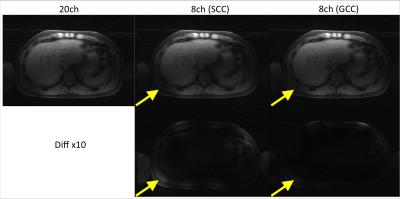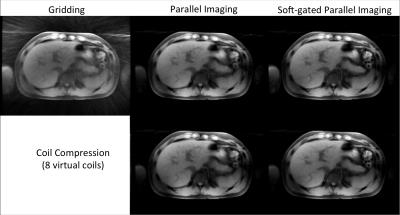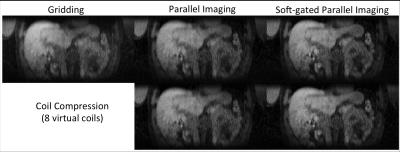1284
Fast motion robust abdominal stack of stars imaging using coil compression and soft gating1Global MR Applications and Workflow, GE Healthcare, Houston, TX, United States, 2Global MR Applications and Workflow, GE Healthcare, Madison, WI, United States, 3GE Global Research Europe, Garching bei München, Germany, 4Cardiac Center of Excellence, GE Healthcare, Garching bei München, Germany
Synopsis
Stack of stars trajectory with golden angle ordering provides better motion robustness than Cartesian imaging for abdominal MRI. However, image reconstruction for non-Cartesian datasets is usually time-consuming, especially for datasets with high-density coil arrays. While additional motion correction methods can improve image quality for stack of stars, they often further increase the reconstruction time. In this work, we aim to reduce the reconstruction time for stack of stars using coil compression and improve motion robustness with a similar reconstruction time using soft gating.
Introduction
Stack of stars trajectory with golden angle ordering provides better motion robustness than Cartesian imaging for abdominal MRI1,2. However, image reconstruction for non-Cartesian datasets is usually time-consuming, especially for datasets with high-density coil arrays. While additional motion correction methods can improve image quality for stack of stars, they often further increase the reconstruction time3,4. In this work, we aim to reduce the reconstruction time for stack of stars using coil compression5 and improve motion robustness with a similar reconstruction time using soft gating6.Methods
(1) Coil compression
Coil compression was applied to reduce the computation for stack of stars reconstruction with high-density coil arrays. A geometric-decomposition coil compression (GCC) method5 was used in this work, including a slice-by-slice coil compression and alignment of coil compression matrices along the slice direction. Compared with single coil compression (SCC)7, GCC exploits the spatially varying data redundancy of coil arrays and can compress data into fewer virtual coils. A similarly application of GCC has been demonstrated in cardiac imaging using stack of stars trajectory8. For standard reconstruction methods, including gridding and SENSE-type of parallel imaging9, the required computation is proportional to the number of coil elements, therefore the reconstruction time can be reduced by $$$\frac{n_c}{n_{vc}}$$$ using coil compression, where $$$n_c$$$ is the original number of coils and $$$n_{vc}$$$ is the number of virtual coils.
(2) Soft gating
Soft gating has been proposed recently for effective motion compensation, in which a motion-weighted data consistency is applied6. Soft gating can be easily combined with parallel imaging6 and compressed sensing10 without lengthening the reconstruction time. In this work, self-navigators were first obtained from the DC signal of the stack of stars datasets for each coil element. Coil clustering11 was then applied to find the dominant motion, and the soft gating weights were generated accordingly.
To validate the proposed methods, an axial free-breathing volunteer dataset was acquired with IRB approval on a GE MR750 scanner using a 20-channel body coil (GE Healthcare, Waukesha, USA) and the following imaging parameters: TE/TR = 1.7/3.6 ms, FOV = 42 cm, slice thickness 4 mm, 54 slices, and 256 spokes per slice. First, both SCC and GCC with 8 virtual coils and gridding reconstruction were evaluated and compared. Different reconstruction methods were then compared, including gridding, parallel imaging (without and with GCC), and soft-gated parallel imaging (without and with GCC). A conjugate gradient (CG) algorithm9 was used in both parallel imaging and soft-gated parallel imaging. The number of CG iterations was kept constant for all methods. All reconstructions were performed in Matlab (Mathworks, MA, USA) on a 2015 MacBook Pro (Apple, Cupertino, USA).
Results
(1) Coil compression
Coil compression results are shown in Fig. 1. GCC has effectively compressed the original data into 8 virtual coils without noticeable compression loss. Compared to SCC, better performance was observed using GCC.
(2) Soft gating
Reconstructed images by all methods are shown in Fig. 2, and reformatted into the coronal plane in Fig. 3. Recorded reconstruction times are shown in Tab. 1. GCC significantly reduced the reconstruction time for parallel imaging and soft-gated parallel imaging. As shown in Fig. 2 and Fig. 3, soft gating improved motion robustness without increasing the reconstruction time.
Conclusion
In this work, we have demonstrated a fast and motion robust method to reconstruct stack of stars datasets for free-breathing abdominal MRI.Acknowledgements
No acknowledgement found.References
1. Winkelmann S, Schaeffter T, Koehler T, Eggers H, Doessel O. An optimal radial profile order based on the golden ratio for time-resolved MRI. IEEE Trans Med Imaging 2007;26:68-76.
2. Feng L, Grimm R, Block KT, Chandarana H, Kim S, Xu J, Axel L, Sodickson DK, Otazo R. Golden-angle radial sparse parallel MRI: combination of compressed sensing, parallel imaging, and golden-angle radial sampling for fast and flexible dynamic volumetric MRI. Magn Reson Med 2014;72:707-717.
3. Cruz G, Atkinson D, Buerger C, Schaeffter T, Prieto C. Accelerated motion corrected three-dimensional abdominal MRI using total variation regularized SENSE reconstruction. Magn Reson Med 2016;75:1484-1498.
4. Yang HJ, Sharif B, Pang J, Kali A, Bi X, Cokic I, Li D, Dharmakumar R. Free-breathing, motion-corrected, highly efficient whole heart T2 mapping at 3T with hybrid radial-cartesian trajectory. Magn Reson Med 2016;75:126-136.
5. Zhang T, Pauly JM, Vasanawala SS, Lustig M. Coil compression for accelerated imaging with Cartesian sampling. Magn Reson Med 2013;69:571-582.
6. Johnson KM, Block WF, Reeder SB, Samsonov A. Improved least squares MR image reconstruction using estimates of k-space data consistency. Magn Reson Med 2012;67:1600-1608.
7. Huang F, Vijayakumar S, Li Y, Hertel S, Duensing GR. A software channel compression technique for faster reconstruction with many channels. Magn Reson Imaging 2008;26:133-141.
8. Kawaji K, Foppa M, Roujol S, Akcakaya M, Nezafat R. Whole heart coronary imaging with flexible acquisition window and trigger delay. PLoS One 2015; 10:e0112020.
9. Pruessmann KP, Weiger M, Börnert P, Boesiger P. Advances in sensitivity encoding with arbitrary k-space trajectories. Magn Reson Med 2001;46:638-651.
10. Cheng JY, Zhang T, Ruangwattanapaisarn N, Alley MT, Uecker M, Pauly JM, Lustig M, Vasanawala SS. Free-breathing pediatric MRI with nonrigid motion correction and acceleration. J Magn Reson Imaging 2015;42:407-420.
11. Zhang T, Cheng JY, Chen Y, Nishimura DG, Pauly JM, Vasanawala SS. Robust self-navigated body MRI using dense coil arrays. Magn Reson Med 2016;76:197-205.
Figures



